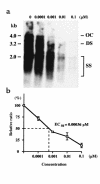The polymerase L528M mutation cooperates with nucleotide binding-site mutations, increasing hepatitis B virus replication and drug resistance
- PMID: 11181644
- PMCID: PMC199250
- DOI: 10.1172/JCI11100
The polymerase L528M mutation cooperates with nucleotide binding-site mutations, increasing hepatitis B virus replication and drug resistance
Abstract
After receiving lamivudine for 3 years to treat chronic hepatitis B, 67-75% of patients develop B-domain L528M, C-domain M552I, or M552V mutations in the HBV polymerase that render hepatitis B virus (HBV) drug-resistant. The aim of this study was to evaluate the influence of these mutations on viral replication and resistance to antiviral agents. We investigated the replication fitness and susceptibility of the wild-type and five mutant HBVs (L528M, M552I, M552V, L528M/M552I, and L528M/M552V) to 11 compounds [lamivudine, adefovir, entecavir (BMS-200475) (+)-BCH-189 (+/-)-FTC (racivir) (-)-FTC (emtricitabine) (+)-FTC, L-D4FC, L-FMAU (clevudine), D-DAPD, and (-)-carbovir] by transfecting HBV DNA into hepatoma cells and monitoring viral products by Southern blotting. The replication competency of the single C-domain mutants M552I and M552V was markedly decreased compared with that of wild-type HBV. However, addition of the B-domain mutation L528M restored replication competence. Only adefovir and entecavir were effective against all five HBV mutants, and higher doses of these compounds were necessary to inhibit the double mutants compared with the single mutants. The B-domain mutation (L528M) of HBV polymerase not only restores the replication competence of C-domain mutants, but also increases resistance to nucleoside analogues.
Figures



Similar articles
-
Novel nucleoside analogue MCC-478 (LY582563) is effective against wild-type or lamivudine-resistant hepatitis B virus.Antimicrob Agents Chemother. 2002 Aug;46(8):2602-5. doi: 10.1128/AAC.46.8.2602-2605.2002. Antimicrob Agents Chemother. 2002. PMID: 12121939 Free PMC article.
-
Genotypic succession of mutations of the hepatitis B virus polymerase associated with lamivudine resistance.J Hepatol. 2000 Sep;33(3):469-75. doi: 10.1016/s0168-8278(00)80284-6. J Hepatol. 2000. PMID: 11020004
-
In vitro evaluation of hepatitis B virus polymerase mutations associated with famciclovir resistance.Hepatology. 2000 Jan;31(1):219-24. doi: 10.1002/hep.510310132. Hepatology. 2000. PMID: 10613749
-
Perspectives for the treatment of hepatitis B virus infections.Int J Antimicrob Agents. 1999 Jul;12(2):81-95. doi: 10.1016/s0924-8579(99)00060-6. Int J Antimicrob Agents. 1999. PMID: 10418752 Review.
-
Detection of hepatitis B virus resistance to antivirals.J Clin Virol. 2001 Jun;21(3):243-53. doi: 10.1016/s1386-6532(00)00167-0. J Clin Virol. 2001. PMID: 11397661 Review.
Cited by
-
Oligonucleotide chip for detection of Lamivudine-resistant hepatitis B virus.J Clin Microbiol. 2004 Sep;42(9):4181-8. doi: 10.1128/JCM.42.9.4181-4188.2004. J Clin Microbiol. 2004. PMID: 15365009 Free PMC article.
-
Clinical pharmacokinetics of alamifovir and its metabolites.Antimicrob Agents Chemother. 2005 May;49(5):1813-22. doi: 10.1128/AAC.49.5.1813-1822.2005. Antimicrob Agents Chemother. 2005. PMID: 15855501 Free PMC article. Clinical Trial.
-
Novel nucleoside analogue MCC-478 (LY582563) is effective against wild-type or lamivudine-resistant hepatitis B virus.Antimicrob Agents Chemother. 2002 Aug;46(8):2602-5. doi: 10.1128/AAC.46.8.2602-2605.2002. Antimicrob Agents Chemother. 2002. PMID: 12121939 Free PMC article.
-
Emergence of a novel mutation in the FLLA region of hepatitis B virus during lamivudine therapy.Antimicrob Agents Chemother. 2005 Jul;49(7):2618-24. doi: 10.1128/AAC.49.7.2618-2624.2005. Antimicrob Agents Chemother. 2005. PMID: 15980328 Free PMC article.
-
Mechanism of entecavir resistance of hepatitis B virus with viral breakthrough as determined by long-term clinical assessment and molecular docking simulation.Antimicrob Agents Chemother. 2010 Feb;54(2):882-9. doi: 10.1128/AAC.01061-09. Epub 2009 Nov 23. Antimicrob Agents Chemother. 2010. PMID: 19933798 Free PMC article.
References
-
- World Health Organization warns of growing “crisis of suffering.” http://www.who.ch/whr/1997/presse.htm. - PubMed
-
- Gordon D, Walsh JH. Hepatitis drugs win approval. Gastroenterology. 1998; 116:235–236.
-
- Honkoop P, de Man RA, Zondervan PE, Schalm SW. Histological improvement in patients with chronic hepatitis B virus infection treated with lamivudine. Liver. 1997; 17:103–106. - PubMed
-
- Lai CL, et al. A one-year trial of lamivudine for chronic hepatitis B. Asia Hepatitis Lamivudine Study Group. N Engl J Med. 1998; 339:61–68. - PubMed
-
- Omata M. Treatment of chronic hepatitis B infection. N Engl J Med. 1998; 339:114–115. - PubMed
Publication types
MeSH terms
Substances
Grants and funding
LinkOut - more resources
Full Text Sources
Other Literature Sources

